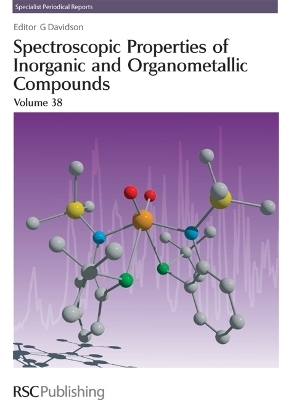
Spectroscopic Properties of Inorganic and Organometallic Compounds
Royal Society of Chemistry (Verlag)
978-0-85404-451-1 (ISBN)
This series provides an unequalled source of information on an area of chemistry that continues to grow in importance. Divided into sections mainly according to the particular spectroscopic technique used, coverage in each volume includes: NMR (with reference to stereochemistry, dynamic systems, paramagnetic complexes, solid state NMR and Groups 13-18); nuclear quadrupole resonance spectroscopy; vibrational spectroscopy of main group and transition element compounds and coordinated ligands; and electron diffraction. Reflecting the growing volume of published work in the field, researchers will find this an invaluable source of information on current methods and applications. Volume 39 provides a critical review of the literature published up to late 2004.
Chapter 1: NMR Spectroscopy in the Liquid and Gas Phases;
1: Introduction;
2: Stereochemistry;
2.1: Compounds of Group 1;
2.2: Compounds of Group 2;
2.3: Compounds of Group 3 (Yttrium, Lanthanides, Actinides);
2.4: Compounds of Group 4;
2.5: Compounds of Group 5;
2.6: Compounds of Group 6;
2.7: Compounds of Group 7;
2.8: Compounds of Group 8;
2.9: Compounds of Group 9;
2.10: Compounds of Group 10;
2.11: Compounds of Group 11;
2.12: Compounds of Group 12;
2.13: Compounds of Group 13;
2.14: Compounds of Group 14;
2.15: Compounds of Group 15;
2.16: Compounds of Group 16;
2.17: Compounds of Group 17;
2.18: Compounds of Group 18;
3: Dynamic Systems;
3.1: Fluxional Molecules;
3.2: Equilibrium Processes;
3.3: Course of Reactions;
4: Paramagnetic Complexes;
4.1: The Transition Metals;
4.2: Lanthanides and Actinides;
References;
Chapter 2: Solid State NMR Spectroscopy;
1: Structure of Solids;
1.1: Group 1;
1.2: Group 2;
1.3: Group 3;
1.4: Group 4;
1.5: Group 5;
1.6: Group 6;
1.7: Group 7;
1.8: Group 8;
1.9: Group 9;
1.10: Group 10;
1.11: Group 11;
1.12: Group 12;
1.13: Group 13;
1.14: Group 14;
1.15: Group 15;
1.16: Group 16;
1.17: Group 18;
2: Motions in Solids;
3: Atoms and Molecules Sorbed onto Solids;
3.1: Water Sorbed onto Solids;
3.2: Other Sorbed Atoms and Molecules;
References;
Chapter 3: Nuclear Quadrupole Resonance Spectroscopy;
1: Introduction;
2: Main Group Elements;
2.1: Group 1 (Lithium-8);
2.2: Group 13 (Boron-11 and -12, Gallium-69 and -71, and Indium-115);
2.3: Group 14 (Germanium-73);
2.4: Group 15 (Nitrogen-14, Arsenic-75, Antimony-121 and -123, and Bismuth-209);
2.5: Group 17 (Chlorine-35 and -37, Bromine 79 and 81, and Iodine-127);
3: Transition Metals and Lanthanides;
3.1: Manganese-55;
3.2: Cobalt-59;
3.3: Copper-63 and -65;
3.4: Lanthanum-139;
3.5: Rhenium-187;
References;
Chapter 4: Characteristic Vibrations of Compounds of Main Group Elements;
1: Group 1;
2: Group 2;
3: Group 13;
3.1: Boron;
3.2: Aluminium;
3.3: Gallium;
3.4: Indium;
3.5: Thallium;
4: Group 14;
4.1: Carbon;
4.2: Silicon;
4.3: Germanium;
4.4: Tin;
4.5: Lead;
5: Group 15;
5.1: Nitrogen;
5.2: Phosphorus;
5.3: Arsenic;
5.4: Antimony;
5.5: Bismuth;
6: Group 16;
6.1: Oxygen;
6.2: Sulfur;
6.3: Selenium;
6.4: Tellurium;
7: Group 17;
8: Group 18;
References;
Chapter 5: Vibrational Spectra of Transition Element Compounds;
1: Scandium, Yttrium and the Lanthanides;
2: Titanium, Zirconium and Hafnium;
3: Vanadium, Niobium and Tantalum;
4: Chromium, Molybdenum and Tungsten;
5: Manganese, Technetium and Rhenium;
6: Iron, Ruthenium and Osmium;
7: Cobalt, Rhodium and Iridium;
8: Nickel, Palladium and Platinum;
9: Copper, Silver and Gold;
10: Zinc, Cadmium and Mercury;
11: Actinides;
References;
Chapter 6: Vibrational Spectra of Some Co-ordinated Ligands;
1: Carbon, Silicon, Germanium and Tin Donors;
2: Dihydrogen Complexes;
3: Boron Donors ;
4: Carbonyl and Thiocarbonyl Complexes;
5: Nitrogen Donors ;
5.1: Molecular Nitrogen, Azido- and Related Groups;
5.2: Amines and Related Ligands;
5.3: Ligands Containing >C=N- Groups;
5.4: Cyanides, Isocyanides and Related Complexes;
5.5 : Nitrosyl Complexes ;
6 : Phosphorus and Arsenic Donors;
7 : Oxygen Donors ;
7.1: Molecular Oxygen, Peroxo, Aquo and Related Complexes;
7.2: Carboxylate and Related Complexes;
7.3: Keto-, Alkoxy-, Ether and Related Complexes;
7.4: Ligands Containing O-N, O-P or O-As Bonds;
7.5: Ligands Containing O-S or O-Te Bonds;
7.6: Ligands Containing O-Cl or O-I Bonds;
8: Sulfur and Selenium Donors;
9: Potentially Ambident Ligands;
9.1: Cyanates, Thio- and Selenocyanates and Their Iso-analogues;
9.2: Ligands Containing N and O, N and P or P and O Donor Atoms;
9.3: Ligands Containing N and S, N and Se or P and S Donor Atoms;
9.4: Ligands Containing S and O Donor Atoms;
References;
Chapter 7: Gas-phase Molecular Structures Determined by Electron Diffraction;
1: Introduction;
2: Compounds of Elements in Group 2 and 13;
3: Compounds of Elements in Group 14;
4: Compounds of Elements in Group 15;
5: Compounds of Elements in Group 16;
6: Compounds of Transition Elements, Lanthanides and Actinides;
References
| Erscheint lt. Verlag | 8.8.2006 |
|---|---|
| Reihe/Serie | Specialist Periodical Reports - Spectroscopic Properties of Inorganic and Organometallic Compounds ; Volume 38 |
| Co-Autor | Keith B Dillon, David W H Rankin |
| Verlagsort | Cambridge |
| Sprache | englisch |
| Maße | 156 x 234 mm |
| Gewicht | 1551 g |
| Themenwelt | Naturwissenschaften ► Chemie ► Analytische Chemie |
| ISBN-10 | 0-85404-451-5 / 0854044515 |
| ISBN-13 | 978-0-85404-451-1 / 9780854044511 |
| Zustand | Neuware |
| Haben Sie eine Frage zum Produkt? |
aus dem Bereich


